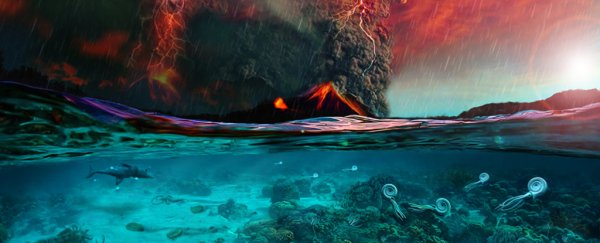Scientists think they've finally come closer to identifying the cause of Earth's worst mass extinction, by tracking down the geochemical trigger that may have started it all.
Known as the Great Dying, the Permian-Triassic extinction event happened around 252 million years ago. The new research is based on a study of fossil shells left behind by clam-like brachiopods in what today is the Southern Alps.
The shells record seawater pH levels which are affected by atmospheric CO2 concentrations, and it looks as though roughly 252 million years ago there was a sudden, intense injection of carbon dioxide into the atmosphere.
It was most likely from a gigantic series of volcanic eruptions in Siberia, the researchers say. The increased warming and ocean acidification would have killed off certain species very quickly, while increasingly nutrient-rich waters would then have depleted oxygen levels in the ocean over a longer time period, causing further extinctions.
"This domino-like collapse of the inter-connected life-sustaining cycles and processes ultimately led to the observed catastrophic extent of mass extinction at the Permian-Triassic boundary," says marine biogeochemist Hana Jurikova who is now at the University of St Andrews in the UK.
The team measured different isotopes of boron and carbon in the shells to get a reading on the seawater acidity using high-precision instruments like the large-geometry secondary ion mass spectrometer (SIMS). Combined with detailed computer models, the data could be used to re-enact the Great Dying.
Scientists have long accepted that a series of volcanic eruptions in what is now Siberia were a key cause of the Great Dying, but this is the first time a reconstruction of the atmospheric circumstances has been made in such detail. This provides us with more information on the underlying mechanisms of what happened on Earth at the time, and what the consequences were over the next several thousand years
This study answers some questions about the combination of events and their sequence, clearly linking the CO2 rise with volcanic activity. The analysis and modelling also suggests that another factor – the release of large amounts of methane by microbes on the sea floor – wasn't so important.
"With this technique, we can not only reconstruct the evolution of the atmospheric CO2 concentrations, but also clearly trace it back to volcanic activity," says marine biochemist Marcus Gutjahr from the GEOMAR Helmholtz Centre for Ocean Research Kiel in Germany.
"The dissolution of methane hydrates, which had been suggested as a potential further cause, is highly unlikely based on our data."
Scientists continue to piece together the story of what happened in the Permian-Triassic extinction based on geological records that are hundreds of millions of years old – not the easiest bit of detective work.
There's still plenty more to discover about what the contributing factors were, how long they lasted, and how some species hung on. Around 96 percent of marine species and 70 percent of terrestrial vertebrate species were killed off for good.
What makes this new study exciting is that it shows how our understanding can be deepened through improved analysis techniques that are coming online, including the use of spectrometry and the study of brachiopod fossils.
"Without these new techniques it would be difficult to reconstruct environmental processes more than 250 million years ago in the same level of detail as we have done now," says marine geochemist Anton Eisenhauer, from GEOMAR. "In addition, the new methods can be applied for other scientific applications."
The research has been published in Nature Geoscience.
